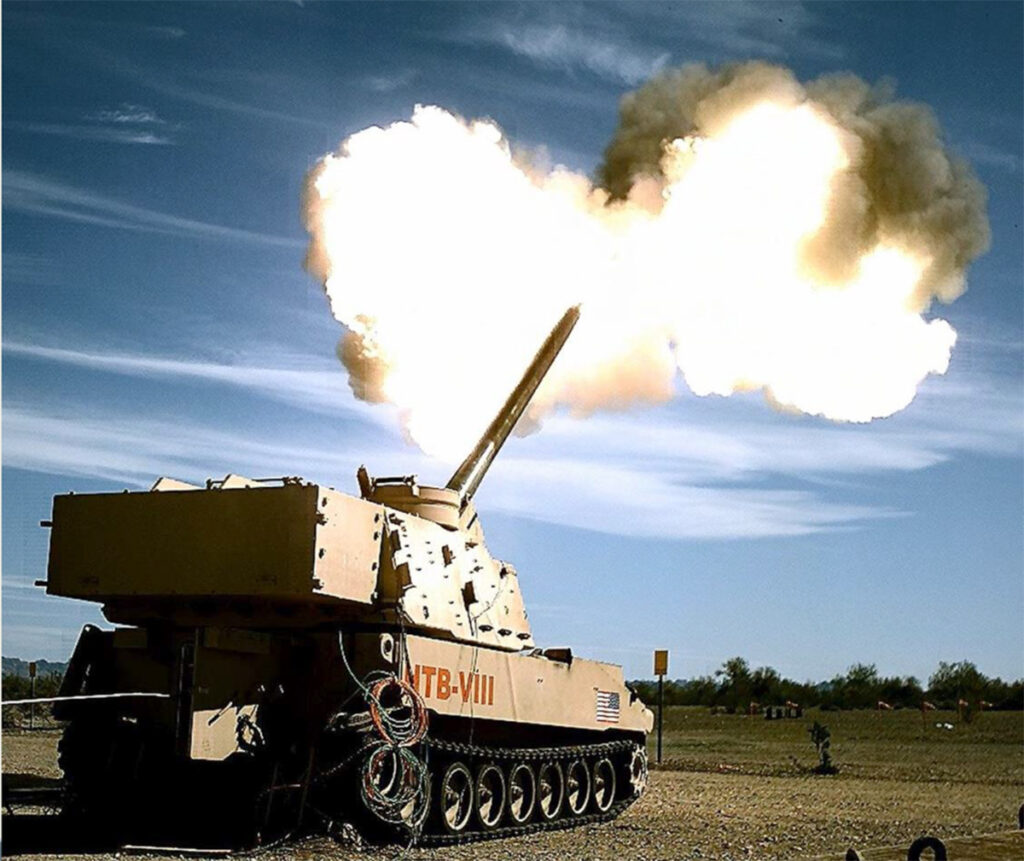
Extended Range Cannon Artillery (ERCA) test shot.
WASHINGTON: Despite flat budgets — at best — the Army’s moving out fast on five new types of armored vehicles – from variants of the venerable Bradley and Paladin, to a Bradley replacement and cutting-edge Robotic Combat Vehicles. Briefings at AUSA’s virtual Global Force Next conference this week made clear the pace and ambition of the effort, and we filled in the gaps with emails to our Army contacts to assemble this master schedule.
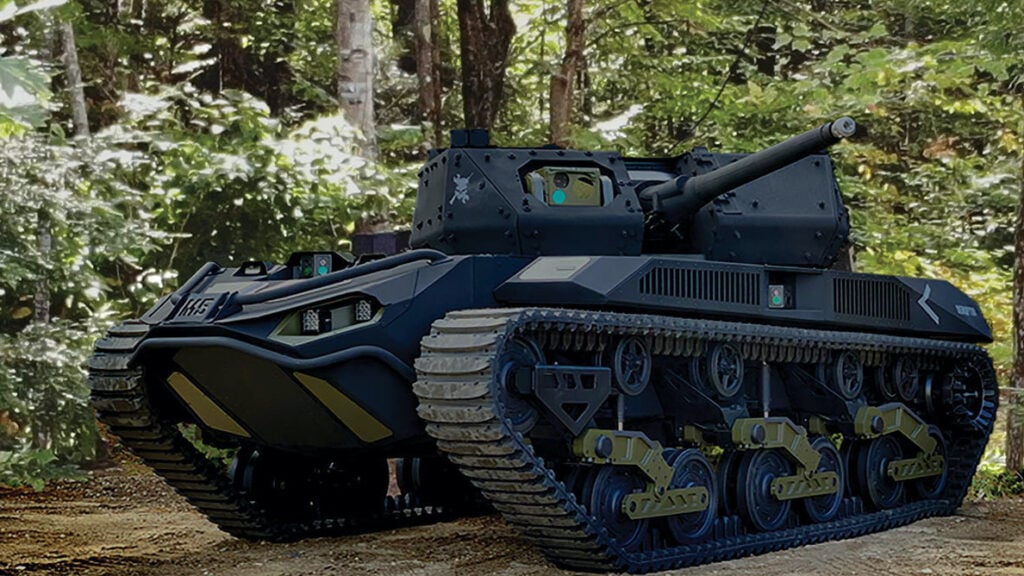
Textron M5 Ripsaw unmanned mini-tank
Robotic Combat Vehicles are potentially the most revolutionary new weapon, although they remain in an experimental phase: The Army’s still exploring the art of the possible and is far from launching a formal acquisition program. Currently, the vehicles are teleoperated, with one soldier driving by remote control and another controlling the sensors and weapons. But according to Maj. Gen. Richard Ross Coffman, the director of armor modernization at Army Futures Command , the objective is to make them more and more autonomous until one soldier can oversee a swarm of 12 robots, moving out ahead of the manned force as an unmanned, (relatively) expendable vanguard.
Alfred Grein, acting director of the Army’s Ground Vehicle Systems Center (GVSC), laid out the current RCV schedule – and the pace is dizzying:
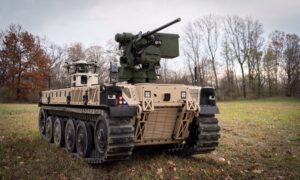
Qinetiq’s Robotic Combat Vehicle – Light (RCV-L)
- QinetiQ delivered a quartet of seven-ton RCV-Light vehicles to the Army in November and December, Grein said. The Army then installed the government-developed RTK (Robotic Technology Kernel) autonomous driving software and shipped the robots to a test center at Texas A&M in January.
- Meanwhile, Textron has delivered a partially completed RCV-Medium – a 12-ton “Ripsaw” mini-tank with a 30 mm cannon – to GVSC for software integration, which Grein says has gone smoothly so far. The first full-up RCV-M will be delivered in April, the remaining three in May.
- In April, all eight RCVs – four Lights and four Mediums — will go to Camp Grayling, Michigan for initial tests as a networked combat formation, alongside four modified M113 tracked transports acting as surrogate RCV-Heavies and six modified M2 Bradleys (known as MET-Ds) serving as the manned control vehicles.
- The shake-out for this company-sized formation – 18 manned and unmanned vehicles altogether – will run through September.
- In November, the vehicles will go to Army Test & Evaluation Command (ATEC) for formal safety testing, which should run through May 2022.
- Then, in June 2022, the Army will begin RCV Soldier Operational Two at Fort Hood, Texas. (SOE-1 was this past summer). That will start with soldier training on the vehicles and work up through complex training exercises to live-fire drills, concluding in August 2022.
At that point, analysts will comb through all the technical data and soldier feedback to come up with recommendations for Army leaders. If all goes as the Army hopes, the service will give the go-ahead to buy and deploy Robotic Combat Vehicles.

The M2 Bradley has been repeatedly upgraded since its introduction, but after 40 years in service, the vehicle is reaching its limits.
The Optionally Manned Fighting Vehicle will replace the Reagan-era M2 Bradley as the Army’s Infantry Fighting Vehicle, a heavily armed and armored troop carrier. But as “optionally manned” implies, OMFV will also draw heavily on the autonomy technology being developed for the Robotic Combat Vehicles, from computer assistance for the two-man crew to a self-driving mode for select missions.
After an initial, overly narrow vision of OMFV elicited only one bidder, the Army rebooted the program and is urging all comers to offer out-of-the-box ideas, from mini-tanks carrying a handful of soldiers to landships carrying 30 infantry in back.
“Given the very broad requirement,” said Brig. Gen. Glenn Dean, Program Executive Officer for Ground Combat Systems, “there are a number of innovative partnerships being formed. I can’t go into the details of what we know, and all that’s not even official until bids come in…. but what we’re hearing is there are a lot of very good ideas that push the envelope.”
- Those bids are due next month, but it’s crucial to understand the Army is only asking for concepts at this stage, not complete designs, and certainly not drivable vehicles. The Army’s deferred detailed design – and a lot of the bureaucratic paperwork – till later in the program. “There is a Request For Proposals on the street now,” Dean told the AUSA conference. “Proposals will come in in mid-April, and we’ll put [the winners] on contract, up to five of them, in the July timeframe, to develop concepts that will shape the Bradley replacement.”
- Concept development work will take place over two years. Then, in early 2023, the Army plans to pick up to three companies to finalize their designs and build a dozen full-up prototypes apiece for testing.
- The following year, in late 2024, OMFV will move out of the streamlined Middle-Tier Acquisition process and become a full-fledge acquisition Program Of Record.
- The final winner will be picked in 2027 and enter production, with the aim of fielding the first full battalion of OMFVs in 2029.
The Robotic Combat Vehicle and Optionally Manned Fighting Vehicle are pushing the cutting edge, especially in automation. The other three major armored modernization programs are less technologically ambitious – but the Army’s taken that as an opportunity to push them all as fast: There are already full-up prototypes of all three.
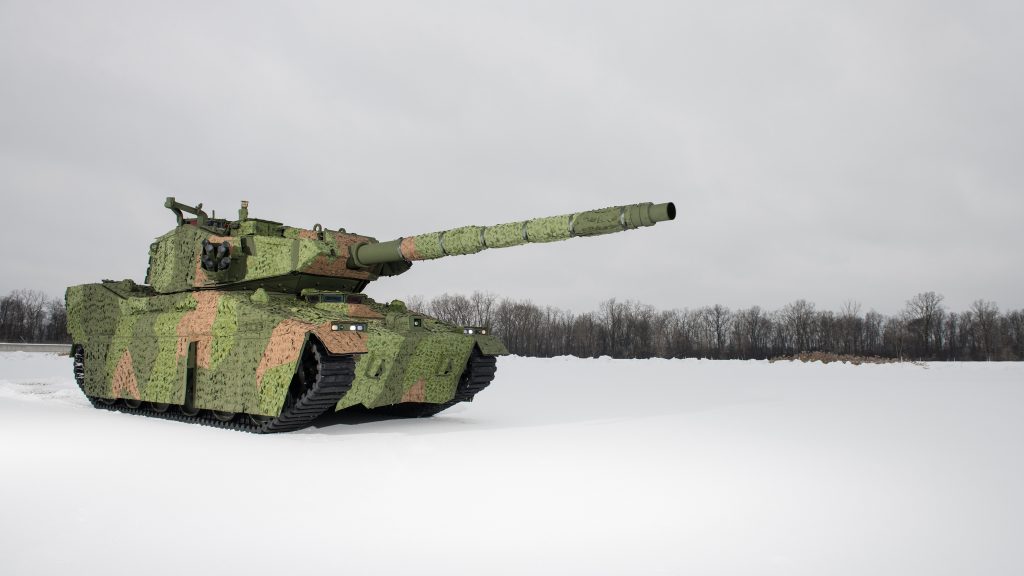
BAE Systems’s prototype for the Army’s Mobile Protected Firepower (MPF) light tank.
The Mobile Protected Firepower (MPF) vehicle is essentially a light tank, meant to be easily deployed by aircraft – potentially even by parachute – and able to cross rickety Third World bridges. The idea is to go where the massive M1 Abrams main battle tank cannot in support of paratroops and other light infantry that normally lack heavy firepower. (The idea is definitely not to engage enemy heavy tanks head-on: MPF won’t have the armor protection for that).
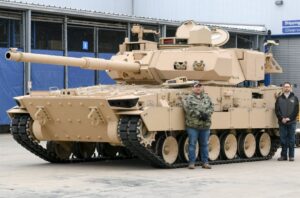
General Dynamics prototype for the Mobile Protected Firepower (MPF) vehicle
- Back in 2018, the Army picked two competitors to build MPF : BAE Systems and General Dynamics Land Systems. The two designs are very different – for one thing, BAE’s is much smaller, with a lighter gun – which gives the Army an interesting and consequential choice.
- Both BAE and GDLS now have prototype vehicles in “developmental test at Aberdeen [Proving Ground] right now,” Dean told the AUSA conference.
- Multiple prototypes of both were also supposed to be at Fort Bragg in January to start a hands-on checkout by the troops, known as a Soldier Vehicle Assessment. But only one manufacturer made that deadline. The Army won’t say which, but we know from our earlier reporting it was General Dynamics, while BAE’s machines were delayed by COVID. According to Dean, there are still only one manufacturer’s prototypes on-hand at Fort Bliss (which must be GD’s), while the other set (which must be BAE’s) will start arriving “later this year.”
- Later this year, the Soldier Vehicle Assessment will wrap up and be followed by a formal Limited User Test, overseen by the Army Test & Evaluation Command.
- ATEC’s grade, in turn, will be a major factor in the formal source selection process in 2022. “By next summer, we should have selected a winner,” Dean said, with production and fielding to start thereafter. The Army has said it wants 504 MPF vehicles for a total life-cycle cost of $16 billion, but sales to foreign militaries and the Marines are also likely.
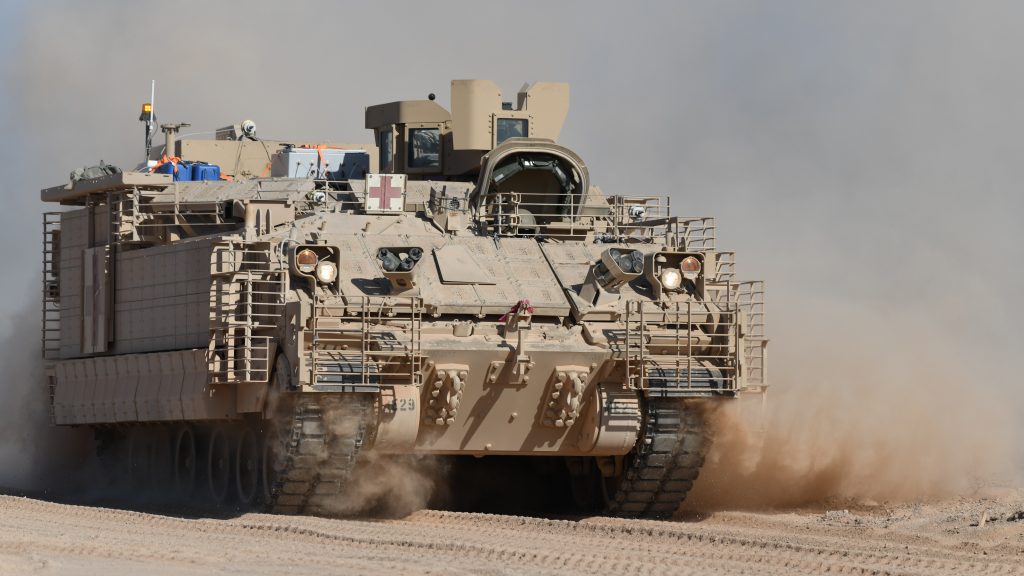
A medical variant of the BAE Armored Multi-Purpose Vehicle. AMPVs will serve as both armored ambulances and mobile operating rooms.
COVID has also delayed production of another BAE war machine, the Armored Multi-Purpose Vehicle to replace the Vietnam-era workhorse, the M113. Quality control has also been an issue on AMPV, Dean acknowledged, in large part because US factories haven’t built large numbers of new armored hulls in decades: Most of the current fleet, while extensively upgraded, was initially built in the 1980s and 1990s.
- BAE was the only bidder in the AMPV competition, offering a turretless variant of its M2 Bradley that could be configured as a general-purpose transport, an armored ambulance, a mobile surgery, a mobile command post, or a mortar carrier for fire support.
- After months of delays, “our production challenges are falling behind us; the last four months have resulted in consistent deliveries,” Dean said. “We have all the five variants of that platform in hand, in their production configurations and in production qualification testing, live-fire testing” – shots are already being fired – “and we’re building the inventory we’ll need.”
- Specifically, the Army needs 64 AMPVs on hand in November to conduct a brigade-sized Initial Operational Test starting in January 2022. If AMPV passes that test, it’ll be cleared for full-rate production.
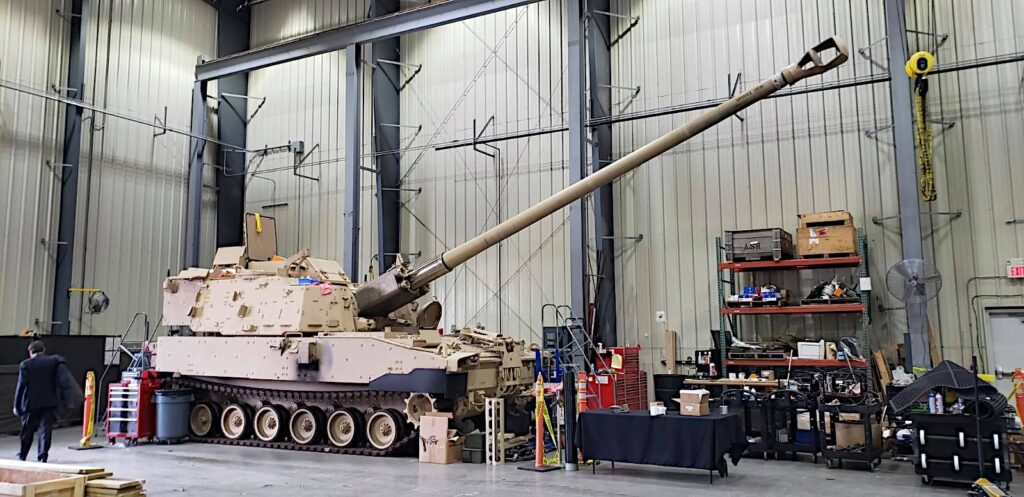
The prototype XM1299 Extended Range Cannon Artillery (ERCA) armored howitzer being assembled at Picatinny Arsenal, NJ.
Fifth, finally, and often forgotten in this context, the Army is developing a new Extended Range Cannon Artillery (ERCA) armored vehicle to replace the M109 Paladin howitzer. (Unlike the other four, ERCA is overseen by Army Futures Command’s artillery modernization team, not Coffman’s armor team).
Now, the M109 has been repeatedly upgraded over the decades since it entered service in 1962: The latest model, the M109A7, features an almost all-new hull using Bradley-derived automotive components. But the Army put so many upgrades in ERCA – a longer cannon in a reworked turret, firing new ammo with new propellant that at least double effective range – that it warranted a change in designation, to M1299.
(The ERCA howitzer vehicles will use the existing armored ammunition carriers, at least for now.)
- The first ERCA prototype was built at the Army’s own Picatinny Arsenal and has already fired its gun in wargames, participating in last fall’s Project Convergence. In April, said artillery modernization director Brig. Gen. John Raffery, leadership of the effort will formally be handed over from Army Futures Command’s Ground Vehicle Systems Center to the acquisition Program Manager for Self-Propelled Artillery.
- This year, the Army needs to test hopefully-final versions of key components, including the formula for the explosive propellant (in layperson’s terms, the gunpowder).
- Then the Army will build at least another 17 ERCA prototypes to equip a full battalion (of 18 howitzers) for a “year-long operational assessment” starting in late 2023.
- Meanwhile, an innovative Army project is working on new ways to feed the ERCA with ammo much faster. That’ll include an automated loader so the crew don’t get worn out manhandling heavy shells. The Army hopes this upgrade will be ready by 2025.
Overall, it’s an ambitious, multi-pronged campaign to overhaul most of the Army’s armored vehicles — a campaign whose success, or indeed survival, will depend very much on the budget wars already underway.






















